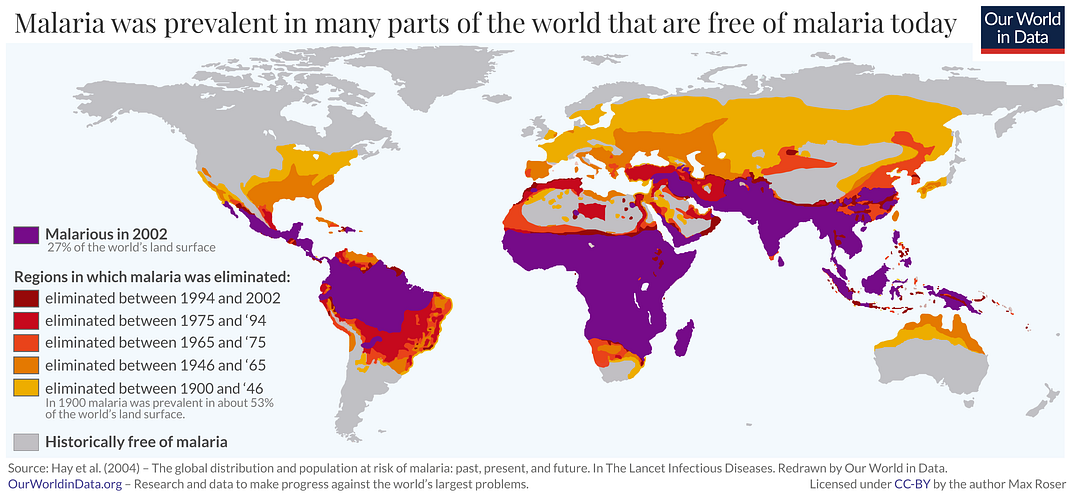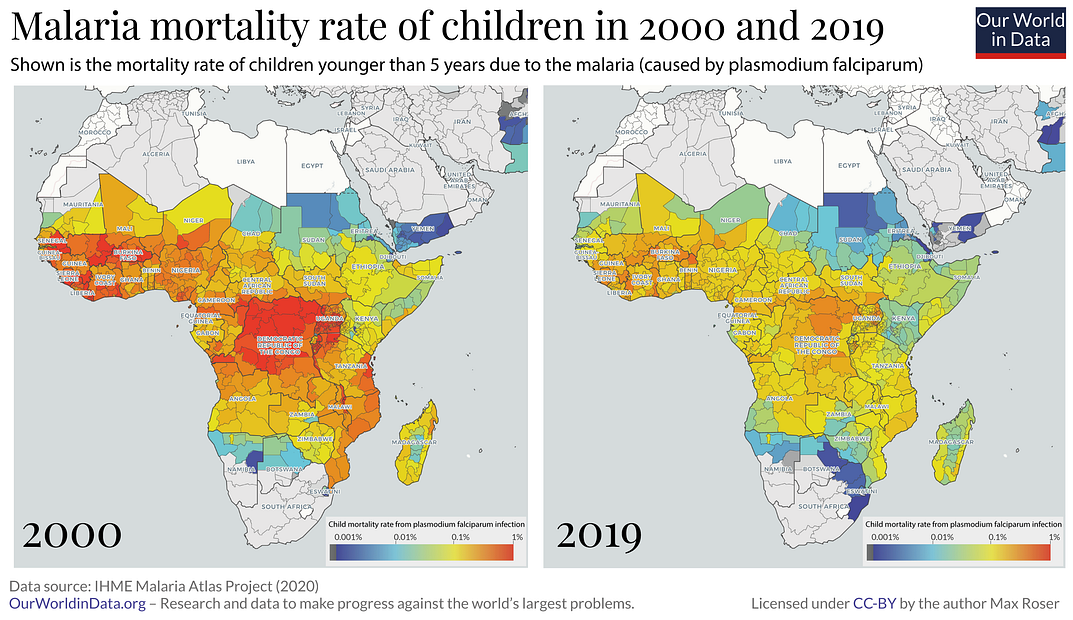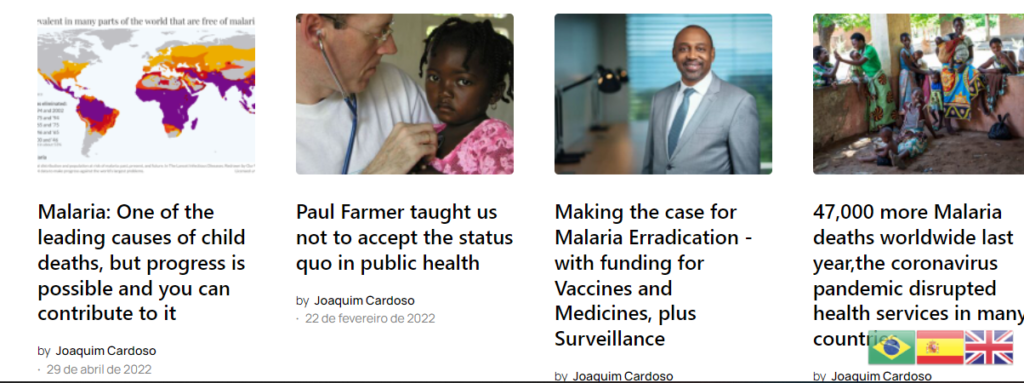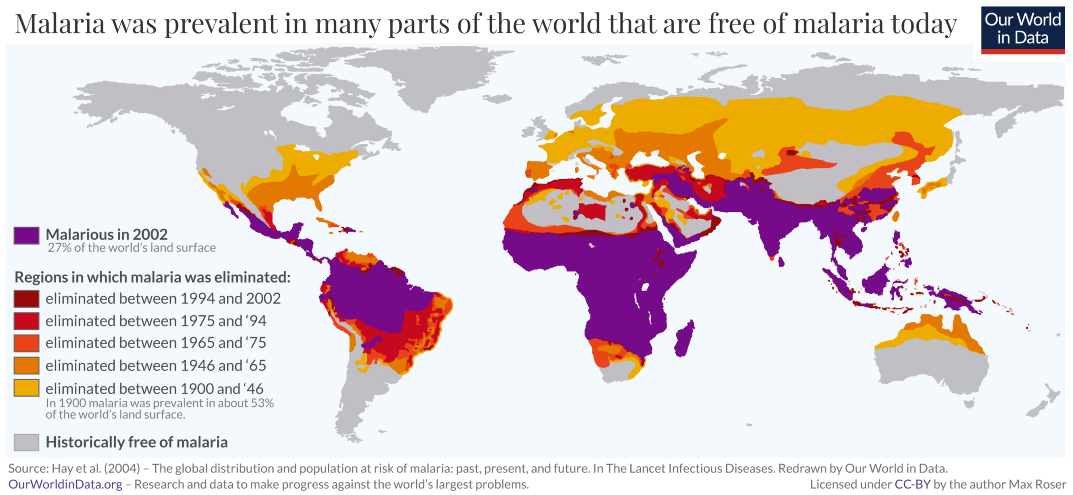Malaria kills about half a million children every year.
Our World In Data
by Max Roser
March 22, 2022
Malaria is a disease that is transmitted by infected mosquitoes. The bite of an infected Anopheles mosquito transmits a parasite that enters the victim’s blood stream and travels into the person’s liver where the parasite reproduces. The parasite, called plasmodium, causes a high fever that involves shaking chills and pain. In the worst cases malaria leads to coma and death.
The World Health Organization estimates that 241 million people contract the disease every year.1
Only a small fraction of malaria victims die from it, but those who die are the very weakest — about three out of four malaria victims are children.2
Malaria is one of the leading causes of child mortality; it kills about half a million children every year. 3 That’s 1320 dead children on any average day.
Malaria is one of the leading causes of child mortality;
it kills about half a million children every year. 3
How can the world make progress against malaria?
In the history of health, the most important progress is often made in the prevention — rather than the treatment — of disease.
For infectious diseases, prevention means interrupting its transmission.
Humanity’s most ingenious way of preventing infections is to achieve immunization through vaccines.
The work on malaria vaccines goes back many decades, but unfortunately these vaccines have not been as successful as the vaccines against other diseases.4
There is however the hope that this will change. The mRNA technology — spurred by the COVID pandemic — seems promising also for the prospect of a vaccine against malaria. But it will certainly still take some time until a highly efficacious malaria vaccine is widely available.
There is however the hope that this will change. The mRNA technology …
In the meantime the world has to protect itself from malaria in other ways. This is something the world has been getting increasingly successful at.
Malaria was common across half the world — since then it has been eliminated in many regions
One line of humanity’s attack is to progressively reduce the area where malaria is prevalent.
Malaria is not a tropical disease. Rather, it is a disease that was eliminated everywhere but the tropics.
Historically, malaria was prevalent in Europe and North America — Oliver Cromwell contracted the disease in Ireland, Friedrich Schiller in Mannheim, and Abraham Lincoln in Illinois.5
The map shows that in modern times the disease has been eliminated not only there, but also in East Asia and Australia and in many parts of the Caribbean, South America, and Africa.
Researchers estimate that historically — and up to around the year 1900 — our ancestors were at risk from malaria across about half of the world’s land surface. Since then the area where humans are at risk of malaria contracted to a quarter.6
The map shows that in modern times the disease has been eliminated not only there, but also in East Asia and Australia and in many parts of the Caribbean, South America, and Africa.
This was achieved through the use of insecticides, the drainage of swampland, and better housing conditions.
Economic growth was crucial for these developments so that the disease is today mostly prevalent in the world’s poorest regions.
The often-repeated claim that malaria killed half of all humans who ever lived is very likely an overstatement, but it is certainly the case that the mosquito-borne fever was one of the most common causes of death in human history.7
In the last few generations humanity gained ground in this long-lasting battle against the disease.
The WHO reports that the global mortality rate has declined by 90% in the 20th century.8
→ More detail in my text Malaria was common across half the world — since then it has been eliminated in many regions

Net Results: how the world is achieving progress where malaria is still prevalent
Economic development is a slow process. Are there opportunities to protect people from malaria right now?
Yes. A surprisingly simple and cheap technology has saved the lives of millions of people in the last few years: insecticide-treated bed nets.
The nets protect those who sleep under them and the insecticide, with which they are impregnated, kills the mosquitoes — in this way the bed nets also protect their larger community, very similar to the way vaccinations do not only protect those who receive the vaccine, but also those around them.
Such public health measures which protect the individual and the people they are in contact with are particularly successful ways to fight global problems.
There is a surprisingly simple and cheap technology has saved the lives of millions of people in the last few years: insecticide-treated bed nets.
The progress against malaria since the turn of the century is shown in the two visualizations below.
The map shows us the change in child mortality due to malaria on the local-level across Africa (for which 2019 is the latest data).
The global annual death toll — across all ages — declined from 900,000 to 630,000 per year. It also shows that the disruptions due to the pandemic led to an increase in malaria deaths.
How was this progress possible?
The study by Samir Bhatt and colleagues 9 in Nature found that three health measures were particularly important for progress against malaria in Africa.
By far the most important measure was the just-mentioned distribution of insecticide-treated bed nets; about two-thirds of the averted cases can be attributed to bed nets.
The rest was achieved thanks to indoor residual spraying and the treatment of malaria cases with artemisinin, a drug discovered by Tu Youyou.
… three health measures were particularly important for progress against malaria in Africa. … distribution of insecticide-treated bed nets; about two-thirds of the averted cases can be attributed to bed nets.
The rest was achieved thanks to indoor residual spraying and the treatment of malaria cases with artemisinin, a drug discovered by Tu Youyou.
She was awarded the Nobel Prize in Medicine in 2015 for this achievement.
Malaria mortality rate of children in 2000 and 2019 10

We can achieve more and you can help
Progress never happens by itself. For millennia our ancestors were exposed to the malaria parasite without defense; the fact that this changed is the achievement of the scientific, political, and economic achievements of the last few generations.
Today we are in the fortunate situation that we have several decades of progress behind us: We can look back and study what worked to use this knowledge to go further.
Some of the most important research in global development asks the question of where additional efforts can do the most good.
A charity evaluator that is doing very rigorous work on this is ‘GiveWell’.
Their research tells you where your donation can have the largest positive impact. It finds that donations to support the fight against malaria are one of the very most impactful ways for you to donate.
At the top of GiveWell’s recommended charities are two organizations that work towards that goal: the Against Malaria Foundation and the Malaria Consortium.
Continuing the successful fight against malaria requires commitment from governments around the world.
It is a problem that we might be able to solve with better technology in the future — most likely with a vaccine — if we choose to support scientific research.
But it is also a problem where each of us can individually contribute to progress right now.
You can read the research about how your donation can contribute to progress against malaria here: GiveWell.org. If you want to contribute to this progress it is possible to make a donation right there.
We do not have to live in a world in which 1320 children die from a preventable disease every day.
We do not have to live in a world in which 1320 children die from a preventable disease every day.
Originally published at https://ourworldindata.org.
RELATED PUBLICATIONS
https://joaquimcardoso.blog/category/malaria/













